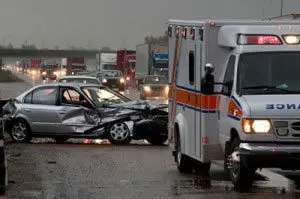What Are the Chances of Dying in a Car Crash?
It is common knowledge that when you climb into a motor vehicle, there is a certain level of risk. Car accidents are, in fact, one of the leading causes of death in the United States. But what exactly are the chances of dying in a car crash?
The Statistical Reality of Fatal Car Accidents
Motor vehicle crashes are a leading cause of death in the United States, taking the lives of over 100 people every day. There are critical factors that increase or decrease the risk of fatality in a car accident, such as the type of car crash, the kind of roadway and road conditions, the type of motor vehicle, the characteristics of the driver, and other factors. The statistical reality of fatal car accidents in the United States is as follows:
- Current fatality rates: In 2023, approximately 44,450 people died in motor vehicle accidents in the United States, according to the National Safety Council (NSC)
- Lifetime odds of dying in a crash: the NSC reports that, for the average American in the United States, the odds of dying in a car accident during the course of their lifetime is 1 in 93, which is about a 1% chance of dying in a car crash
- Comparison to other causes of death: in the United States, there is a greater chance of dying from heart disease, cancer, accidental opioid overdose, and suicide than there is of dying in a car accident
Lost a loved one in a car crash? Contact the fatal car accident lawyers at Munley Law for compassionate legal guidance.
High-Risk Factors That Increase Fatality Chances
 There are several risk factors that increase the likelihood that there will be fatalities in a car accident. In many cases, a fatal car accident could have been prevented by adopting certain safety measures. Some of the high-risk factors that increase the chances of fatality include the following:
There are several risk factors that increase the likelihood that there will be fatalities in a car accident. In many cases, a fatal car accident could have been prevented by adopting certain safety measures. Some of the high-risk factors that increase the chances of fatality include the following:
- Age and gender considerations: the driver’s age is an important risk factor in the likelihood of a fatal car accident as younger drivers tend to be inexperienced, and older drivers tend to have slower response times. Gender differences in risk-taking also play a part, with male drivers generally displaying more tolerance for risk
- Time of day and weather conditions: nighttime driving and inclement weather cause poor visibility for drivers, and rain and snow cause slippery road conditions that contribute to loss of control of the vehicle and a diminished reaction time
- Road types and locations: rural roads with a high-speed limit often have fewer safety measures in place, and this increases the risk of a fatal car crash
- Vehicle types and safety ratings: Smaller motor vehicles and older models with outdated safety features are at greater risk of being involved in a car accident that results in injuries or at least one death
Impact of Driver Behavior on Fatality Risk
Driving behavior has a significant impact on the fatality risk in a car accident. Unsafe driving habits, including not wearing a seat belt or driving while impaired, increase the risk of dying in a car accident. Some common behaviors that place the driver and others at a higher risk of fatality include:
- Distracted driving: distracted driving claimed approximately 3,308 lives in 2022, according to the National Highway Traffic Safety Administration (NHTSA)
- Speeding-related deaths: drivers exceeding the speed limit is a leading cause of car accidents, claiming the lives of approximately 12,151 people in the United States in 2022
- Drunk driving fatalities: Drunk driving crashes take the lives of about 37 people a day in the United States. In 2022, 13,524 people died in alcohol-impaired driving traffic accidents
- Aggressive driving incidents: road rage, tailgating, switching lanes without signaling, driving through red lights and stop signs, and weaving in and out of traffic are all aggressive driving behaviors that increase the risk of fatal car crashes
Injured by a negligent driver? Contact Munley Law for expert representation.
Survival Rates by Car Accident Type
Whether an individual survives a car accident depends on several different factors. However, certain types of car accidents generally result in more serious injuries or fatalities. Generally, survival rates by crash type are as follows:
- Head-on collisions: When vehicles traveling in opposite directions collide head-on, the impact force depends heavily on their speeds. Due to the tremendous frontal impact energy, head-on collisions at higher speeds often prove fatal. Lower-speed head-on collisions typically cause injuries but have a better survival rate because the collision forces are less severe.
- Rollover accidents, which occur when a vehicle tips on its side or roof, can cause serious bodily injury and fatality. Rollover accidents may involve one or more vehicles, but the most common type of rollover accident is a single-car accident. The type of motor vehicle influences the survival rate of a rollover accident, whether seat belts were in use at the time of the accident, and the safety equipment in the vehicle
- Side-impact crashes, also known as T-bone accidents, are among the deadliest car accidents. These crashes are particularly dangerous because there is very little space between the vehicle occupant and the exterior of the car and the point of impact. Side-impact car crashes account for approximately 22% of car accident fatalities every year
- Rear-end collisions are the most common type of motor vehicle crashes in the United States. While rear-end car crashes generally result in no or minor injuries, these car crashes do account for approximately 7.5% of fatal traffic accidents every year in the United States
Been in a serious crash? Let Munley Law evaluate your case for free.
Chances of Dying in a Car Accident: Pedestrian and Cyclist Fatalities
 Pedestrian and cyclist deaths have risen steadily in recent years across the United States. These fatalities often result from a combination of factors, including speeding, inadequate infrastructure, larger vehicles, poor road design, insufficient bike lanes, limited lighting, lack of safe crossings, heavy traffic, and distracted driving.
Pedestrian and cyclist deaths have risen steadily in recent years across the United States. These fatalities often result from a combination of factors, including speeding, inadequate infrastructure, larger vehicles, poor road design, insufficient bike lanes, limited lighting, lack of safe crossings, heavy traffic, and distracted driving.
In 2022, approximately 7,600 pedestrians lost their lives in traffic incidents. During the same year, bicycle accidents resulted in 337,640 injuries and 1,084 cyclist deaths from motor vehicle collisions. Urban areas record the highest number of pedestrian accidents compared to rural regions.
Nighttime poses particular dangers, with most fatal incidents occurring between 6 PM and 11 PM due to reduced visibility. This time window consistently shows the highest death rates for both pedestrians and cyclists.
Recent Trends in Fatal Accidents
Understanding patterns in fatal motor vehicle accidents helps identify key risk factors and inform safety measures.
- Annual fatality statistics: the National Safety Council reports that motor vehicle fatalities in the United States are showing a decline, with a decrease of 3.25% during the first quarter of 2024 compared to the same period in the previous year
- Geographic variations: more fatal car accidents occur in urban areas, but the likelihood of dying in a car accident is statistically higher on rural roads
- Seasonal patterns: the summer season has the highest rate of car accidents as well as a higher rate of car crash fatality compared to the winter months
- Demographic trends: younger drivers between the ages of 16-20 are most likely to be involved in a car accident; drivers over the age of 65 years are the least likely. The number of males dying in car accidents is almost double the number of females dying in a car accident.
Legal Options After a Fatal Crash
 When there is a fatal car accident, the survivor’s family members may pursue legal action against the responsible party to seek justice for their loved one. Surviving family members may seek compensation for lost wages, medical expenses, and other losses. These legal actions include:
When there is a fatal car accident, the survivor’s family members may pursue legal action against the responsible party to seek justice for their loved one. Surviving family members may seek compensation for lost wages, medical expenses, and other losses. These legal actions include:
- Wrongful death claims: a wrongful death lawsuit is a civil claim filed by the victim’s surviving family members that seeks to recover compensation from the negligent party for the losses they sustained in the car accident
- Survivor benefits: survivor benefits from a car accident are financial compensation that covers losses such as medical expenses, lost wages, funeral costs, and loss of companionship. This is generally obtained from the at-fault driver’s insurance company as part of a wrongful death lawsuit
- Insurance considerations: Most states require that drivers carry liability insurance that has a minimum coverage. For example in Pennsylvania drivers must carry $15,000 coverage for injuries to one person and $30,000 total for an accident. Some insurance policies carry a funeral benefit if you or a family member dies as a result of a car accident
- Statute of limitations: The statute of limitations for filing a personal injury claim after a motor vehicle crash varies by jurisdiction. Legal deadlines for filing claims can range from several months to several years following the incident. It’s important to check local laws and consult legal professionals about applicable time limits.
Did you lose a family member in a crash? Let our car accident attorney in Allentown, Scranton and Reading fight for justice and compensation.









